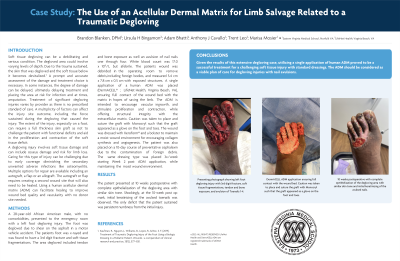Case Series/Study
(CS-030) The use of an acellular dermal matrix for limb salvage related to a traumatic degloving.

A degloving injury involves soft tissue damage and can include osseus damage and risk for limb loss. Caring for this type of injury can be challenging due to early coverage diminishing the secondary unwanted adverse infections like osteomyelitis. Multiple options for repair are available including an autograft, a flap or an allograft can be utilized. The autograft or flap requires creating a second wound site that will also need to be healed. Using an acellular dermal allograft can facilitate healing to improve wound bed quality and vascularity with no donor site needed.
Methods:
A 28-year-old African American male, with no comorbidities, presented to the emergency room with a left foot degloving injury. The foot was degloved due to shear on the asphalt in a motor vehicle accident. The patients’ foot was x-rayed and was found to have a 3rd digit fracture and soft tissue fragmentations. The area degloved included tendon and bone exposed as well as nails one through four were avulsed. White blood count was 17,000 but afebrile. The patient was debrided in the operating room to remove debris including foreign bodies. The wound was free of debris, so a single application of a human acellular dermal matrix was placed ensuring full contact of the wound bed with the matrix in hopes of saving the limb. The wound measured 5.4 cm x 7.8 cm x 0.5 cm with exposed structures. Caution was taken to place and suture the graft with 4.0 Monocryl where the graft appeared as a glove on the foot and toes. The wound was dressed with xeroform and a bolster to maintain a moist wound environment encouraging collagen synthesis and angiogenesis. The patient was also place on a ten-day course of preventative cephalexin due to the contamination of the initial foreign debris. Continued dressings three times a week starting week two post dermal matrix application, continued to maintain the moist wound environment.
Results:
The patient presented at week ten post op with complete epithelialization of the degloving area and keratinizing of the avulsed nails. The only deficit the patient sustained was persistent numbness from the initial injury.
Discussion:
Utilizing an acellular dermal matrix proved to be a successful treatment for challenging soft tissue injury with a single application. The acellular dermal matrix should be considered as a viable plan of care for degloving injuries and nail avulsions.
Trademarked Items: DermACELL AWM ®, LifeNet Health, Virginia Beach, Virginia
References: Kaufman, R., Nguyen, J., Williams, B., Lopez, R., & Boc, S. F. (2019). Treatment of Traumatic Degloving Injury of the Foot Using a Biologic Dressing in a Pediatric Patient. Wounds: a compendium of clinical research and practice, 31(12), E77–E81.

.png)